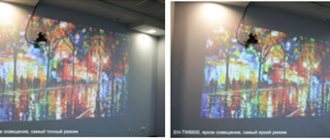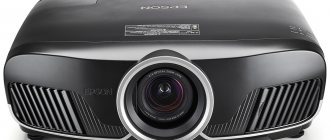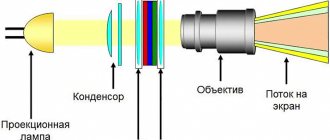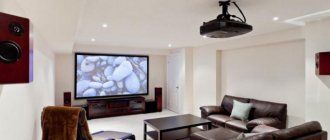A projector is a device that connects to a video camera, laptop, PC, or tablet in order to display the image on a large screen. The remote control is used to control the operating device. The design of a video projector is quite complex, and may differ depending on the technology used to compose the image. Exactly how the projector will work depends on the technology used. Today on the market you can find LCD, DLP, LCoS models. Let's take a closer look at these and other, less popular technologies.
LCD projectors
Today LCD models are the most common due to their affordable cost. However, apart from the low price, they are unlikely to stand out with other advantages. Of course, you can watch videos at home on such projectors, but you need to do it from afar. Up close, only multi-colored dots will be visible. In addition, the contrast also leaves much to be desired. We should not forget that these models are initially positioned as budget ones, so the lamp installed in the projector is the cheapest, and the matrix resolution does not reach HD. You can only enjoy viewing on this projector in completely darkened rooms. However, even in such conditions, due to the low quality of the transmitted image, some particularly small details will simply not be visible.
Projectors with three LCD matrices have higher image quality, which does not deteriorate even when viewed closely. The use of improved image transmission technology conveys many more color tones. In 3LCD video projectors, image enhancement is achieved through the use of special technologies. Each color has its own monochrome matrix. First, each light stream passes through its own matrix, and then, using a prism, they are combined into one bright and multi-colored image.
Working principle of a 3LCD projector
Although 3LCD projectors have much better brightness and color reproduction than their budget counterparts, they also have their drawbacks. Compared to DLP projectors, the contrast is not too high. This is due to the characteristics of the LSD matrix. None of them, even the most expensive ones, are capable of providing complete color non-transmission; as a result, it will not be possible to achieve a deep black color.
In addition, all liquid crystal matrices require regular blowing with cold air. This procedure is mandatory in order to reduce the negative impact of high temperatures on them. However, constant airflow causes the formation of a layer of dust on the matrix, which cannot be avoided even by installing filters and regularly cleaning them.
You may be interested in: comparison of DLP and LCD projectors.
What is the best projector resolution? 4K projector vs HD images
A good native resolution for a projector is at least full HD with a resolution of 1920x1080 pixels. Cheaper lower native resolution projectors are available, but purchasing lower native resolution projectors below Full HD resolution is strongly discouraged at this time.
Read: Home theater projector: How to choose and which one is better to buy?
The sharpness in 4K image quality only becomes apparent to the viewer when the image is viewed on large screens. For example, on a 65-inch TV, the difference between 4K and HD images is difficult for the average viewer to notice, even close-up. But if these same 4K and HD images are broadcast on a 100-inch screen or larger, the clarity and sharpness of the 4K image will be very obvious. Thus, the better image quality of a 4K projector becomes very noticeable compared to the image of an HD projector.
For those who can afford it, the best projector resolution available today is 4K Ultra HD with a resolution of 3840x2160 pixels. Images produced by higher resolution projectors are much smoother and more enjoyable to watch. See the above example of a human eye, enlarged to compare the eye in the HD image with the eye in the 4K UHD image. These pixel patterns become more obvious as the image zooms in.
DLP technology
The operation of DLP projectors is based on the action of a special DMD chip, which contains many small rotating mirrors. They are responsible for the formation of the matrix.
High-resolution DMD chips contain a huge number of microscopic mirrors. The principle of operation is that light from the lamp passes through a disk with multi-colored sectors, which rotates, and hits the matrix. As a result, when the projector is turned on, the image appears as the light beam passes through the corresponding colored sectors of the disk.
The controls in DMD chips are located differently than in LSD models. They are located behind the mirrors, so DLP projectors have almost no distance between pixels.
The technology used in these models allows you to obtain an image with increased contrast. This can be achieved due to the fact that the mirrors, which are responsible for the black pixels, are located in a certain position. Because of this, it is possible to achieve the appearance of a true black color.
Although DMD chips are much less susceptible to high temperatures, there is a heat sink located on the rear side. At the same time, there is no need to worry about dust - the projector optics are located in a hermetically sealed housing.
Currently, LED-DLP projectors are most widespread. They do not use light passing through a moving wheel. Instead, there are colored LEDs that turn on one by one. Their brightness is too low. However, unlike gas-charging lamps, LED lamps are small in size and weight, and also last much longer.
The main disadvantage of DLP projectors is the appearance of a rainbow effect, which is especially noticeable during dynamic scenes. This is due to the fact that color components are projected one at a time and can be mixed with frequent frame changes. In addition, gray color is very difficult to reproduce on DLP projectors. The mirror must be rotated as accurately as possible so that the eye can catch the sequence of pixels of different colors changing into a gray tint.
Is it worth buying a 3D projector?
With a high-quality 3D projector, you can watch fantastic films in 3D. But many people use the 3D feature very rarely after its novelty wears off after a few weeks. So it's a personal matter whether it's worth overpaying for a 3D projector. If price is not a factor for you, then it will always be better to have a projector with 3D functionality along with the necessary 3D glasses.
Read: How and which TV is better to choose and buy: Everything you need to know
The way 3D movies work is that two images are displayed simultaneously on the projector screen: one for the right eye and one for the left eye. The trick to shooting 3D movies is that they are shot with 3D cameras, which have two lenses side by side, roughly the same distance apart, like our eyes.
Images from the left and right lenses are recorded separately and when 3D movies are shown on the screen, the image for the left eye is shown first, followed immediately by the image for the right eye at about 24 frames per second for each eye. Special 3D glasses allow the left eye to see only images intended for the left eye and similarly for the right eye. This leads to the fact that we see 3D images as three-dimensional.
LCoS (SXRD, R3LCD, D-ILA)
The developers of this technology managed to eliminate all the shortcomings of previous models of video projectors. At the same time, all their most positive qualities were preserved and improved.
Here, the image is formed, as in 3LCD projectors, by passing rays through matrices. However, they do not pass through, but are reflected from a layer of mirrors, as in DLP models. The pixel controls are on this mirror layer behind the pixels, which are placed close together. This eliminates the rainbow effect and improves image quality.
Of course, this technology has disadvantages. The main one is the high price. LCoS projectors are significantly more expensive than similar DLP and 3LCD models, which have the same, and sometimes even higher, characteristics. Therefore, these projectors are currently used only by professionals to create high-quality presentations and installations.
This is interesting: rating of the best projectors for the home in 2021.
Projector as the basis of a home theater
""“ to contentsLCD, DLP, D-ILA... these abbreviations hide very specific models of digital projectors that can be found among home theater components. They all differ from each other in design features, video playback quality, and price. How to figure this out?
When selecting home theater , the question often arises of choosing between different methods of displaying video. What to prefer - a regular TV, a computer monitor, an LCD screen or a plasma panel? Of course, it all depends on the personal preferences of the buyer. However, don't miss out on another opportunity to enjoy your favorite movie. projector along with a special screen can become a means of demonstrating video
So, today you can choose not only between plasma panels, LCD TVs, but also digital projectors with different image formation technologies. As for the latter, some of them are quite popular, accessible and cheap. Others are more promising, but also more expensive, and some even exist in single copies, personifying the inevitable and wonderful future.
CRT projectors
Based on the operating principle, these models are reminiscent of the good old cathode ray tube (CRT) televisions. These projectors use three powerful picture tubes, each for its own color. Using a special optical system, three images are combined into one, resulting in a color image.
The disadvantages of CRT projectors are their large size, high cost, and, most importantly, low luminous flux intensity, so you can only watch movies on them in a darkened room. Therefore, these models are now very rarely used in home theaters. At the same time, CRT projectors currently provide the most natural color reproduction. So such devices are still produced, but only for very high-class systems, for which a separate room is allocated in the house.
LCD projectors (LCD)
Liquid crystal technology has long been well known to most users from computer monitors, laptops and LCD TVs. a digital LCD projector is not much different from its “intelligent” counterparts. The principle of image formation is that light, passing through a matrix of crystals, receives the color that individual pixels, i.e., individual crystals, transmit. Moreover, color formation in the most “advanced” projectors occurs using three different matrices, each of which is responsible for its “own” color. Mixing with each other, three streams of light form a single color picture, which the viewer sees on the screen.
Almost all the advantages and disadvantages of LCD projectors are well known; fortunately, there are plenty of similar devices (not just projectors). The merits include very rich and saturated colors, even if not the most realistic. We must also not forget that LCD technology appeared quite a long time ago, which means that most of the shortcomings in the models have been eliminated, the positive features have been brought to perfection, and the main directions of development have long been defined. In addition, LCD projectors are cheaper than their “brothers” created on the basis of other technologies.
However, it is worth mentioning the disadvantages. There are plenty of them. These are the already mentioned unrealistic colors, which manufacturers naturally struggle with. In addition, the resolution of the image is limited by the number of cells (pixels), moreover, when light passes through the matrix, the power of the light flux decreases, which means that the overall efficiency of the projector is not the highest. Increasing the lamp power leads to heating of the liquid crystal matrix, which in turn shortens its service life and produces not entirely correct color reproduction. In addition, the switching speed of each cell is not so high that it does not affect the image quality at all. If the time it takes for one cell to transition from inactive to active is long enough, the dynamic image may become somewhat blurry. However, the developers cope with this drawback quite successfully.
DLP projectors
Compared to projectors with LCD matrices, DLP models look much more promising and “advanced”. Digital Light Processing (DLP) is an original technology invented by Texas Instruments. This time, the image formation is based on the reflection of light from thousands of small mirrors arranged on a single DMD (Digital Micromirror Device) matrix. Each mirror is a miniature polished aluminum plate that is attached to the matrix and can take two different positions, at different angles. This happens under the influence of an incoming signal, and in one position the light is reflected through the lens of the lens and creates an image, but in another it is not. Since the mirror switching speed is very high, by controlling each mirror, you can create a picture of variable brightness - the human eye is simply not able to notice such manipulations.
In the simplest case, light, before hitting a matrix with mirrors, penetrates through a round rotating filter with alternating colored zones. Thus, an image is alternately created on the screen in several basic colors. And again, the speed of changing pictures is such that our eye sees a bright and clear picture.
In the most “progressive” DLP projector, the image is formed on three matrices with mirrors, and the light no longer passes through a rotating filter. It is split by prisms into the necessary components - each colored light stream is reflected separately and only before passing through the projector lenses are the streams mixed again.
The relative simplicity of DLP technology determines the main advantages of DLP projectors. Unlike LCD models, they work on reflection, not transmission. This allows you to obtain a more powerful luminous flux. In addition, the elements of the DMD matrix are located closer to each other than in the case of an LCD, which has a positive effect on both the overall brightness of the image and its integrity - individual elements (pixels) are almost invisible. In addition, the DMD matrix heats up much less than the LCD matrix, which gives a higher quality and more accurate color picture. DLP projectors also accurately reproduce dynamic images, since the DMD matrix does not suffer from inertia, switching almost instantly. More accurate color rendition is achieved by strictly dosing the number of mirror switches, and black color and all shades of gray are realistic and correct. And finally, the most important trump card in the fight against competitors in this case is, perhaps, the ability to create more compact and lightweight devices based on DLP.
However, these projectors also have some disadvantages. Such small mirrors sometimes tend to “stick”, thus distorting the final image. Engineers are fighting this, and quite successfully. In addition, any picture formed by alternating several initial ones may suffer from some blurriness - when using one or another model, this manifests itself in different ways. Sometimes (very rarely) the human eye is able to perceive the alternation of different colors on the screen. To avoid this result, manufacturers raised the frame rate from the base 60 per second to 120 and even more. There is also the so-called “color flash” effect, caused by desynchronization of the rotation of the color filter relative to the scan. In modern DLP projectors, this effect is practically invisible to the user.
LCOS (D-ILA) projectors
In projectors based on D-ILA technology (this is a special case of LCOS - Liquid Crystal on Silicon), light from the lamp hits a special matrix of liquid crystals, but does not pass through it, but is reflected from the shiny substrate, then penetrates the crystals and forms image on the screen. This achieves several positive points. Firstly, the picture turns out to be quite bright and saturated. Secondly, the matrix size can be larger than that of a conventional LCD (up to 4000#2000 pixels). Thirdly, all electronic control elements of the cells are located under the crystals, and not between them. This makes it possible to reduce the gap between pixels so much that the image becomes higher quality and “smoother” than even DLP projectors .
The most modern, but also the most expensive models contain three LCOS matrices, each of which forms its own color image, which are then mixed and the resulting image is displayed on the screen. But there are also single-matrix versions of projectors - they have an additional layer responsible for dividing the light flux into three color components. Such devices are cheaper, but the picture quality in this case is lower.
By the way, about the price. D-ILA projectors produce the most decent, highest-resolution images, but they will also cost more. In addition, they are more difficult to make compact, mobile and lightweight. So such models are still used mainly by professionals.
LDT projectors
When starting to talk about LDT technology, it must be emphasized that this time we are looking into the possible future of digital projectors. Such devices are based not on an ordinary lamp, but on a laser. Moreover, not even one laser, but three. Each laser has its own wavelength (628 nm, 532 nm and 446 nm), and each is responsible for its own color (red, green and blue). The laser beam is amplitude modulated, then combined into a common signal with other lasers, and this resulting signal travels through an optical cable to a special mirror device. It, in turn, reflects the laser beam in two planes - vertical and horizontal. Thus, line by line, the laser draws the picture.
This technology has enormous advantages over all other imaging methods. The laser beam is capable of creating the clearest and most contrasting picture on any screen, regardless of its size and shape. Yes, even on spherical surfaces you will get clear and high-quality video. The possible contrast value of the picture is simply amazing - 50,000:1! At the same time, natural, bright and rich colors are preserved. And most importantly, there is no longer any need to worry about beam convergence and sharpness. Naturally, modern LDT projectors are able to reproduce any video standards.
It is clear that technology of this level is not cheap. Working and used projector samples cost hundreds of thousands of dollars. Currently, such models are mainly used in some planetariums in different cities of the world. In addition, individual “instances” are used in the military sphere for a variety of realistic simulators. Naturally, the owners of the technology are striving by any means to reduce the cost of production of laser projectors, so that in the near future such devices will appear in professional cinemas, and then in home systems.
Projection TVs
Let's say that for some reason installing a projector, which is small but requires some experience in using it, is not entirely convenient. After all, this device should stand at some distance from the screen and display a “flat” picture both vertically and horizontally. This will likely require some configuration. The screen can also cause inconvenience. If there is no permanent place for it, then it will have to be installed and then folded again. And there are times when the overall design of the room does not tolerate any unnecessary elements...
That's when the projector can be replaced by a projection TV . In terms of shape, size and design, this is the same TV familiar to every user. Therefore, such a device will easily fit into any interior.
An LCD or DLP projector is installed inside the body of a projection TV . The beam from it is reflected by the mirror and falls on the screen, which works for transmission. In this case, the image quality is almost the same as when using a conventional projector, but the entire system remains quite compact.
So where should we stop?
So, you need to decide what will become the basis of your home theater? In front of you, on the one hand, are flat panels - plasma and liquid crystal. On the other hand, there are compact digital projectors. And somewhere in the middle between them are projection TVs. Each solution has its own advantages and disadvantages. Let's summarize.
Plasma panels impress with their solidity and size (there are “instances” with a diagonal of 80″!). They also produce images that are bright, albeit with some lack of depth in blacks and other dark colors. Modern models have excellent contrast and impressive viewing angles. On the other hand, plasma screens consume a huge amount of energy, they are quite bulky and require special care in handling.
LCD TVs cannot boast of such decent dimensions as plasma ones, but they are economical, compact (especially in terms of thickness), lightweight and affordable. True, the contrast of LCD models is lower, absolute black is a dream for them, viewing angles are small, and “broken” pixels are still a fact.
A digital projector has a number of advantages over other display media. So, unlike a plasma panel, the pixel structure in the picture it “draws” is much less noticeable. If we are talking about a large screen, then a projector is the most suitable solution that saves both money and space in the house. After all, this device can be put away in a closet if necessary, and the screen can be rolled up with a motor.
There are many models of digital home theater projectors on the market now, ranging from $1,500 to $50,000. The choice of a specific system is dictated by your size and price requirements. If you need something smaller and cheaper, then it is better to purchase an LCD projector . And if the main thing for you is quality, and the cost of the device and its dimensions are not so important, preference should be given to the DLP model. A CRT projector is a solution for very serious image connoisseurs who are willing to spend tens of thousands of dollars on the purchase and installation of equipment.
And yet, if a TV receiver in the interior is more common than other options, then a projection TV may be the best choice. Unlike “plasmas”, it does not need to be mounted on the wall, adjusted for image uniformity, like an unsuccessfully installed projector, it does not require additional screens or anything else. Then why not get one? There are projection TVs based on both LCD and DLP technology. The image quality of the latter is higher, but the price is much higher. In addition, the choice of DLP-based projection TVs is still very limited.
In any case, a projector is by no means the privilege of individual “advanced” home theater owners. This is a successful and justified solution that provides high image quality. As for the large screen, in this case the projector can be called not only the most worthy, but also the most economical option.
Reprinted from the website of Alexander Zudkov
CRT technology
This technology can be considered the oldest, since it is based on a cathode ray tube (CRT). Although CRT technology has been used for several decades, nevertheless, it is still relevant and in terms of image quality characteristics (clarity, resolution, color rendition) it is not inferior to modern and more expensive methods of image formation. Another advantage of CRT is the greater reliability of electrical circuits and the duration of continuous operation of the tube, exceeding the limit of 10,000 hours.
This technology also has a wide dynamic brightness range and black depth that no other technology can provide.
Despite their undoubted advantages, CRT devices are still inferior in some respects to modern devices.
- The units have a large mass (several tens of kilograms). If the manufacturer made them a little lighter, it would be possible to more conveniently transport and install this equipment.
- Brightness levels range from 100 to 300 ANSI lumens, while in modern devices the level can reach 10,000 ANSI lumens or more. For this reason, watching videos is only possible in a well-darkened room.
- To achieve good image quality, a lot of adjustments are required, and sometimes it is difficult to do without the involvement of a specialist.
It is worth noting that today it is almost impossible to find a projector of this type in retail sales. It has been superseded by more modern technologies described above.
Inside the CRT video projector there are 3 CRTs with screens with a diagonal of 7 to 9 inches. Each CRT is designed to output one color (green, red, blue) of the RGB color model.
The principle of operation of the projector can be described as follows: the input signal is divided into components by color, which are involved in the control of modulators. At the same time, the intensity of the beam begins to change. At this moment, the beam, passing through the magnetic field and deflection system, subjects the surface of the phosphor-coated screen to scanning from the inside. After this, a one-color picture is created on the screen. Next, it is projected through the lens onto an external screen.
As a result, 3 images are simultaneously projected on the external screen, and when mixed, a full-color picture is obtained.
Everything you need to know about front projectors, article. Portal “www.hifinews.ru”
The very first projectors used an oil film light modulation system and were an analogue cathode beam and optical device to control a powerful stream of light to create an image on a very large screen.
Save and read later -
Basics
What is a front video projector?
A front video projector is an electronic device that converts video image signals into a light flux that is projected and focused onto a screen located at some distance from the projector. Unlike film projectors, some types of front projectors have only a few moving parts, and image quality is determined by a significantly larger number of settings, both in the user and service menus.
A Brief History of Front Projectors
The very first projectors used an oil film light modulation system and were an analogue cathode beam and optical device to control a powerful stream of light to create an image on a very large screen. Based on the mass-produced Swiss system "Eidofor" and the Russian analogue Ariston, in particular, the first large television screen (black and white) of the Space Flight Control Center of the USSR and the American NASA was implemented.
The main unit of such a projection system is a mirror, the surface of which is coated with oil and a special film. Under the influence of an electric charge when scanning the mirror with an electron beam, the oil surface is deformed and becomes “rough,” due to which individual areas differently reflect the light flux directed from a special xenon lamp. The reflected light creates a giant image on the screen.
Dr. Fritz Fischer and the Swiss Federal Institute of Technology conceived this projector back in 1939 (in Zurich) and the first prototype was presented in 1943. All NASA information during the Apollo space program (1968) was displayed on the screen of such a projector.
In our country, an analogue of Eidofor called Ariston was developed at the Moscow Research Television Institute and subsequently produced at the Lvov Television Plant.
CRT projectors (Cathode Ray Tube).
Back in 1972, Sony (Japan), as well as Advent (USA), released the first CRT projectors, which were equipped with three small (four-inch) high-brightness cathode ray tubes. A similar CRT technology was used at that time in conventional televisions. A beam of electrons painted an image on the phosphor-coated inner surface of the tube screen. To obtain a color image, three beams were needed, one each for the red, green and blue channels. The projector's image was formed and focused by lenses onto a large screen, the same but smaller in size than in city cinemas. High overall brightness (300 lumens), high contrast ratio (1,000,000:1) and long tube life (10,000 hours) were excellent characteristics for a projector of its time. But it required more complex initial setup and calibration than modern models.
Kloss Novabeam.
This projector was created by the famous audio and video inventor Henry Kloss based on his pioneering work in the field of CRT projectors at Advent since 1972. The Kloss projector used a specially designed CRT tube with a built-in optical system. This innovation made it possible to improve the focusing of the light flux and obtain a more detailed image with more accurate color rendition. The overall design was also cheaper, making the Novabeam the most popular projection system of the early 1980s. A portable model for projecting onto a white wall or screen was introduced in 1982, equipped with a computer input, and enabled the creation of the first home and office front projection systems with VGA (640 x 480i) resolution.
The first digital projectors.
The limitations of the analog technology of the first front-facing CRT projectors, which dominated until the end of the twentieth century, were overcome by researchers from the American company Hughes and the Japanese JVC, based on whose developments a single company, Hughes-JVC Technology Corp., was formed in 1996. Through joint efforts, projection technology was created - ILA (Imaging Light Amplifier), which is an analog reflective LCD system combined with infrared CRT technology to form an image. This system delivers unheard of light output (more than 12,000 lumens) and resolution (2000x1200) in a $250,000 JVC D-ILA-12K projector.
At the same time, another American company, Texas Instruments, developed the first digital system - DMD (Digital Micro Mirror Device), which became the basis for projectors with DLP (Digital Light Processor) technology. DLP technology uses millions of tiny rotating mirrors to create an image. Since 1999, based on DLP and LCOS technologies (analogues of D-ILA and SXRD), analogue projection systems in cinemas and home installations have begun to be replaced.
Many modern projectors support 1080p. Since the introduction of HDTVs from Zenith in the USA (1996), many projectors have also received an HD set-top box, although not all have Full HD resolution (Full HD 1920x1080p), some have a resolution of 720p (1280x720p) or 1080i (1920x1080). . Higher resolution requires increased computing power and processing speed, which was a luxury not allowed until 2005. To more accurately recreate the signal with the projector, external processing units are often used. And even today, not all front projectors can offer Full HD format, but the situation is likely to change in the near future.
Technologies
What is CRT?
A cathode ray tube (CRT), or CRT in English, is a device in the form of a vacuum tube with an electron gun emitting a beam and a phosphor screen, which is used in televisions to view images. As early as 1939, black-and-white commercial television broadcasting began in the United States using the first CRT televisions, which had a screen of approximately nine inches diagonally. However, World War II delayed the development of television until about 1952. Actually selling home color CRT televisions appeared in 1964. Their competition with public cinemas based on other display technologies continues with modern HDTVs, which have received a screen enlarged to 40 inches or more with an aspect ratio of 4:3 and 16:9.
In 1971, Sony and Henry Kloss, then working at Advent, developed the first commercial CRT projection televisions with a front projection system. The era of home cinema began with viewing on a large wall screen several meters diagonally. The largest television tubes (picture tubes) at that time measured only 25 inches diagonally across the screen.
What is DLP?
Developed by Texas Instruments in 1996, the Digital Light Processor (DLP) projection system consists of millions and millions of microscopic mirrors (originally called DMD - Digital Micro-Mirror Display). A beam from a white light source is directed to a DLP chip, each micromirror of which reflects or absorbs light corresponding to one pixel on the screen. The system has the highest contrast ratio and picture refresh rate for home systems today (120,000 Hz).
What is D-ILA?
In 1999, JVC introduced projectors based on the developed D-ILA (Direct Imaging Light Amplifier) technology using reflection from a special LCD matrix. The original name was LCoS (Liquid Crystal on Silicon). The special design of the matrix allows you to increase the fill factor, i.e. pixel density on the reflective matrix and screen. The fill factor of D-ILA projectors is up to 91 percent, while for LCD projectors it is 60%, and for DLP technology this figure reaches 88%. LCoS became the second technology to achieve 4K resolution.
What is SXRD?
Sony's version of LCoS technology is called SXRD (Silicon Reflective Display). The fill factor of this technology is 92%, due to this, individual pixels are almost indistinguishable, and the image on the screen has a “seamless” effect. The refresh rate of the screen image is 8 microseconds. Based on SXRD technology, the first projector in 4K resolution was created, and there is the potential to double the resolution to 8K.
What is LCD?
LCD (Liquid Crystal Display) is a liquid crystal display based on liquid silicon crystals, which can become transparent or opaque under the influence of a control voltage. For the first time, LCD displays began to be widely used in wristwatches, replacing LED indicators. Nowadays, many monitors, TVs and projectors use a light source passing through the LCD panel to produce images, as opposed to reflective technology, as is the case with LCoS. In all likelihood, you are reading this text on a computer LCD monitor. Special LCD matrices are also used in projectors.
Multi-chip and single-chip projectors
In all front (and rear) digital projectors, the entire color palette displayed on the screen is obtained by mixing three basic colors (red, green and blue). In single-chip DLP systems, a pinhole disk (also called a color wheel) rotates very quickly, sequentially selecting the three primary colors for projection. This method may create a noticeable rainbow effect for some people, which can detract from the overall viewing experience.
Three-chip DLP projectors are free from this drawback, where a separate DLP chip is used for each primary color.
HDMI inputs and cables
With the widespread transition to digital television in 2003, an interface called HDMI (High-Definition Media Interface) was developed to connect signal sources and displays. Essentially, HDMI has the same electrical characteristics as DVI-D, the interface for connecting displays to a computer. But HDMI uses a much smaller 26-pin connector and supports HDCP (High Definition Copy Protocol) copy protection technology. HDMI is currently used for connections between high-definition copy-protected devices such as Blu-ray and HD-DVD players, cable and satellite receivers, and televisions.
Video processing
Video processing is used to convert one resolution (for example, VGA 640x480p) to another, usually higher resolution (for example, Full HD 1920x1080 p), as well as to change the aspect ratio of the image (for example, enlargement, full screen filling or widescreen format), to remove noise and artifacts to produce a sharper, cleaner image. The first company to create high-end video processors for consumer video equipment was Faroudja. In 1997, video processors combined with the Runco projector made it possible to create impressive image quality from SD television programs and DVDs. Currently, at least 20 companies produce video processors for video processing and scaling.
Internal video processing
Since the first portable industrial digital projectors appeared in 1999, the need to increase the resolution or, in other words, upscaling video recordings has become obvious. The fact is that these first digital projectors had a resolution (2048x1200p), which was significantly higher than the standard 800x600p used at that time. The ability to increase resolution available in modern projectors allows you to obtain the maximum image size and reduce artifacts.
External video processing
The need for external video signal processing arose with the advent of signal sources with a resolution higher than VGA and corresponding monitors around 1996. The desire to scale video information in the 640x480i format to computer resolution (800x600p) and higher then required complex ADC and DAC converters capable of operating in the gigahertz range. Solving such a problem in real time sometimes required a whole room with computers and other equipment. Companies such as Faroudja and Snell & Wilcox were able to develop more compact equipment, initially for military purposes, and eventually commercial versions appeared, from Faroudja and Runco in 1997.
Installation and configuration of video projectors
Installation
Some projectors have the ability to mount to the ceiling, which maximizes the audience's view of the screen and makes setting up the projector easier. If the projector must be hidden when not in use, a motorized lift design is often used. Sometimes, additional external cooling or a special ventilation system is required, as the amount of heat generated from super bright large lamps in a small home projector housing can become excessive.
Projection distance
In general, it is the relationship between lens magnification and the distance from the projector to the screen. A typical ratio is 2:1 and means that the distance from the projector to the screen should be twice the width of the screen. Therefore, if the screen is 3 meters wide, the projector should be located 6 meters away from it.
Light flow
As defined by the SMPTE and ANSI standards, the luminous flux of home projectors should be between four and 96 foot-lamberts (1 foot-lambert = 1 lumen per 1 square foot), lamps used in projectors should provide a brightness of 100 - 10,000 lumens. Obviously, a luminous flux with a reduced brightness level to achieve a satisfactory contrast ratio requires a special darkened room, otherwise the image will appear blurry. A brighter luminous flux can create an image on the screen that can be viewed in daylight. Brightness choices vary depending on screen size, projection distance, lighting conditions, and personal taste. In urban cinemas, the required luminous flux level is 16 foot-lambert.
Keystone distortion
These characteristic image errors occur when the projector is not positioned correctly in relation to the screen. Keystone distortion is an effect where one side of a screen image is wider than the other, causing objects on one side of the screen to appear taller or thicker. Some projectors (since 2000) have built-in a digital keystone correction function, which, through video signal processing, allows you to correct the image geometry. But this method has the side effect of reducing resolution.
Video calibration
Calibration is an important tool for obtaining the optimal and most reliable image. Any display can be calibrated and all displays require regular adjustment to obtain a true and accurate image.
What is video calibration?
Since the first color CRT televisions (1953), regular tuning and adjustment of monitors used in television studios has become a necessity. Accurate color reproduction requires careful adjustment of the gain and offset of the primary electron beam sources for red, green, and blue. Later (1971), with the advent of commercial CRT projectors, similar RGB adjustments were required for them. Thus, calibration becomes a prerequisite for achieving an accurate image. As a result of video pioneers such as Joe Kane and the Imaging Science Foundation, consumer awareness of the need for calibration has increased significantly, demonstrating that the factory settings of flat-panel TVs and projectors rarely produce images without serious distortion. Calibration is the only way to get a reliable image.
ISF (Imaging Science Foundation)
The Imaging Science Foundation was founded in 1994 by Joe Kane and Joel Silver to educate consumers and manufacturers about the need for proper adjustment and tuning of video displays and projection systems. They have trained and certified several thousand calibrators who now professionally tune home video systems to achieve the most accurate images possible. Prices for such services in America range from $350 to $2500, depending on the technology and the number of sources.
Why you shouldn't use factory settings
TV and projector manufacturers believe that most consumers want hyper-realistic images. The picture at factory settings often looks bluish and overly sharp, the resolution is deliberately lowered in order to present an image free from noise. Compounding the problem are many modern movie theaters that do not meet the standards set by the Society of Motion Picture Engineers (SMPTE). As a result, the image often has errors in brightness, color and clarity.
Contrast ratio
Contrast ratio is the ratio between a 100% white level signal and a signal corresponding to the reproduced black color. Several different methods are used to estimate contrast ratio. Increased contrast provides a more realistic picture on the screen.
The incredibly high contrast values for TVs and projectors sometimes demonstrated in individual tests only really make sense under certain laboratory viewing conditions. Any light in the viewing room can reduce the depth of blacks and/or change the optical perception of the human eye, so that all those high values become essentially meaningless. Some projectors are often capable of delivering superb images with a minimum contrast ratio of 3000:1, which is only a tenth of the amazing performance of some manufacturers.
Why you shouldn't exaggerate the contrast value
It is not entirely correct to think of contrast as the determining factor for an accurate image. Reproduction accuracy depends not only on contrast. Consider an example in which the bright part of the image is 100% signal level, and the dark parts of the image are 1000 times darker, or 0.1% level. The eye easily detects dark areas of the image. But in reality, the 300:1 contrast level shown in most cinemas is sufficient, which is often considered the de facto standard for video playback.
Screen selection
Selecting a screen for a front projector is another important step in the HD projector installation process. Particular attention should be paid to the following aspects.
Gray screen
Gray material screens can increase contrast and were first introduced in 2003 by Stewart Filmscreen. The company's research led to the creation of the current Stewart Studiotek screen, which uses 18% neutral gray instead of a neutral white surface. This can improve contrast and black levels with some digital projectors that have poor or average black levels. This screen also somewhat compensates for ambient light and improves the contrast ratio by as much as 18%.
Required screen illumination level
Screen light level is very important to create a realistic and accurate image. Too much light can cause eye fatigue, and too little light results in flat, dimensionless images. Typical screen illumination levels should be between 4 and 96 ft-lamberts, with the ideal SMPTE value being 16 ft-lamberts. However, lower levels are much more common, with most movie theaters displaying screen illumination of around eight foot-lamberts.
The importance of a dark room
The actual contrast ratio largely depends on the lighting. Any light in a room with a front-facing projector running will reduce the black level and the picture will look hazy. Particular attention should be paid to the color and materials used for the side walls and ceiling, but equally important are the colors of carpets, furniture and curtains. When all these nuances are properly taken into account, most home theaters can present the highest range of brightness levels and a much higher contrast ratio than equivalent urban cinema settings.
Prepared from the portal “www.hifinews.ru”, December 2010.
This article has been read 5,753 times.
The article is included in the sections:
How to choose. Buyer's Guide
Computer from scratch
A projection device/projector (from the Latin projicio - I throw forward) is an opto-mechanical device for projecting enlarged images of various objects onto a screen.
The first projector was invented by the German physicist and mathematician Athanasius Kircher in 1640, calling his device a “magic lantern.” The device, in which a candle served as the light source, made it possible to create shadow projections of images of people, animals or objects cut out of cardboard on the screen.
Modern projection devices project images from the monitor screen onto the screen and connect to a PC. In computer projectors, a special electronically controlled modulator is used as the source of the projected image, to which a signal is supplied from the PC video adapter. The modulator is used as a controlled light filter that modulates the light flux from the projection lamp.
The designs and principles of operation of modulators are very diverse, although they are mainly built on the basis of LCD panels.
In a multimedia projector , the projection lamp, LCD matrix and optical system are structurally placed in one housing, which makes them similar to overhead projectors designed for viewing slides or filmstrips.
According to the principle of operation, a multimedia projector is no different from an overhead projector: the image is created using a powerful projection lamp and an electro-optical modulator built into the projector, controlled by a signal from the PC video adapter, and then projected onto an external screen using an optical system. The main difference in multimedia projectors is the design of the modulator and the methods of constructing and transferring the image to the screen.
Benq Multimedia Projector
Depending on the design of the modulator, projectors are of the following types:
- TFT projectors;
- polysilicon projectors
- DMD/DLP projectors.
Depending on the method of lighting the modulator, multimedia projectors are divided into transmissive and reflective type projectors .
TFT projectors
In TFT projectors ,
related to transmissive type projectors, a small-sized color active LCD matrix made using TFT technology is used as a modulator. The operating principle of a transmissive type TFT multimedia projector is illustrated in Fig. 1.
Operating principle of a transmissive type TFT multimedia projector
The main element of the installation is a miniature LCD matrix made using TFT technology, like the LCD screen of a flat panel color monitor . Uniform illumination of the surface of the LCD matrix is achieved through the use of a lens system called a condenser.
Polysilicone projectors
Polysilicon multimedia projectors are also translucent type projectors and are used when it is necessary to obtain a brighter image. They use not one color TFT matrix, but three monochrome miniature LCD matrices about 1.3″ in size . Each matrix produces a monochrome image in red, green or blue. The optical system of the projector as shown in Fig. 2, ensures the combination of three monochrome images, resulting in the formation of a color image. This technology is called polysilicon ( p - Si ) .
Each polysilicon matrix element contains only one thin film transistor, so its size is smaller than that of a TFT matrix element, which allows for
improved image clarity .
Operating principle of translucent polysicone multimedia projector
Color separation system
polysilicon projector
, consisting of two dichroic ( D 1 D 2 )
and one conventional (N1) mirrors (Fig. 2), is used to decompose the white light of the projection lamp into three components of primary colors (red, green, blue).
Color separation must be performed in order to supply each of the three monochrome matrices with a luminous flux of the corresponding color. A dichroic (color separation) mirror transmits light of only one wavelength (one color) and is a highly polished glass substrate coated with a thin film of dielectric material.
Color mixing system
The polysilicon projector consists of two dichroic
( D 3 D 4 )
and one reflective
( N 2 )
mirrors and is used to obtain a color image by superimposing three monochrome images created by corresponding LCD matrices.
Polysilicon projectors provide higher image quality, brightness and color saturation compared to TFT projectors . They are more reliable and durable , since three LCD matrices operate in a less intense thermal regime than one. Thanks to this, polysilicon projectors can be used when projecting images onto a large screen in rooms such as conference rooms and cinemas.
DMD/DLP projectors
Reflective LCD projectors are designed for use in large auditoriums and differ in their operating principle: it is not the transmitted light that is modulated, but the reflected light flux.
Currently, the technology most used in reflective LCD projector designs is DMD/DLP , developed by Texas Instruments .
In reflective DMD / DLP , the light source emission is modulated by the image when reflected from the matrix.
DMD/DLP projectors use a matrix consisting of many electronically controlled micromirrors, each of which is about 1 micron .
Each micromirror has the ability to reflect the light incident on it either into the lens or into the absorber, which is determined by the level of the electrical signal applied to it.
When light hits the lens, a bright screen pixel is formed, and a dark one forms in the absorber. Such matrices are designated by the abbreviation DMD (Digital Micromirror Device) , and the technology on which their operating principle is based is DLP ( Digital Light Processing )
.
Typically, one DMD matrix contains about 848 x 600 = 508,800 micromirrors, which exceeds the SVGA resolution (800 x 600 = 480,000 pixels).
To obtain a color image, two types of projectors are used: with three or one DMD matrix.
Three-matrix projector , the diagram of which is given in Fig. 3, the method of forming a color image is similar to polysilicon (see Fig. 2).
In single-matrix DMD/DLP projectors, a full color frame is created by sequentially superimposing three rapidly changing monochrome frames: black-red, black-green and black-blue. The change of monochrome frames on the screen is imperceptible due to the inertia of human vision. Monochrome frames are formed by sequential illumination of the DMD matrix with a beam of red, green and blue colors. A beam of each color is formed by passing the luminous flux g of a projection lamp through a rotating disk with red, green and blue light filters, as shown in the diagram of a single-matrix projector (Fig. 4). The micromirror control is synchronized with the rotation of the light filter.
Diagram of a single-matrix reflective multimedia projector
Compared to LCD technologies, DLP technology has the following advantages:
- almost complete absence of image graininess,
- high brightness and uniformity of its distribution.
The disadvantages of single-matrix DMD projectors include noticeable flickering of frames.
Liked the article, recommend it to your friends!
↑How to install such buttons?↑











